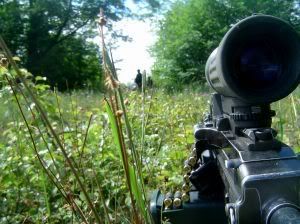What to do in an Ambush
 I have some friends who are policemen, some who are SWAT team members, and some who are in the military. Suffice it to say that they are all highly trained. One is an expert marksman, one an expert tracker, one has twenty years on the beat, and another is a decorated officer. It is always interesting to get together with them and hear the stories they tell. The lack of intelligence in the common criminal is astounding, but I guess they wouldn’t be criminals if they were intelligent. It is also interesting to listen to them talk about tactics for different situations. I remember one discussion in particular was what the military trains their troops to do in case of an ambush. Now I never expect to find myself in that situation, but the concepts they teach are easily applicable to dealing with life’s daily problems.
I have some friends who are policemen, some who are SWAT team members, and some who are in the military. Suffice it to say that they are all highly trained. One is an expert marksman, one an expert tracker, one has twenty years on the beat, and another is a decorated officer. It is always interesting to get together with them and hear the stories they tell. The lack of intelligence in the common criminal is astounding, but I guess they wouldn’t be criminals if they were intelligent. It is also interesting to listen to them talk about tactics for different situations. I remember one discussion in particular was what the military trains their troops to do in case of an ambush. Now I never expect to find myself in that situation, but the concepts they teach are easily applicable to dealing with life’s daily problems.
In a nutshell, an ambush is an armed attack by an enemy force that takes the defenders by surprise. Typically the attackers have a terrain advantage such that the defenders are caught in the open with little opportunity for cover. So picture you and a group of your soldier buddies are walking in a field and suddenly from the trees around you, gunfire erupts. What do you do?
Well the first instinct is to retreat to a defensible position. That is human nature. Look for a place to hide until you can regroup and formulate a response. What is interesting is that the best response when the ambush strikes is not to retreat to a defensible position, but rather to charge the attackers. This has two benefits. First, a retreat under fire is an ugly and uncoordinated thing. People get in each other’s way, stumble over each other, and if you turn and run, you have no vision of what the attackers are doing. Also, in a well-planned attack, the avenue of retreat will be directed by the attackers so that while you are running away, your foe knows exactly where you are heading and how you will get there.
When charging your attacker, you are behaving unpredictably which throws your assailant off balance. You are keeping your attacker in your cone of vision and you are moving towards an area of cover. The final benefit to charging is that you are actually able to apply a counter-attack, not something you can do to when retreating. By running in unpredictable patterns, you can help lessen the chance of being hit and hopefully dispatch your attacker.
Useful information to know, but how can you apply to your normal life, you know, the one where you are not involved in fighting a war? Stressful issues often come out of the blue. One moment you are minding your own business, the next, a loved one is in the hospital, or a financial plan falls apart. Your first instinct is to retreat and not think about it, not deal with the problem. Instead of retreating, though you need to charge full steam at the issue. Face it head on and take the actions necessary to defeat it.
When a group of soldiers retreat from an ambush, the ambushers are still there and must be confronted at a later date. The problem is, the enemy is not going to sit in the same place and wait for you to counter-attack. No, they are going to move around and again find an advantageous spot. So by retreating, you still face the same foe and they are still better prepared than you.
Now, charging into the face of an attacker is not a natural action. It takes the Army a lot of training to break that first response of running away. So the first few times you face a something stressful in this manner, it will be difficult. But by persevering and practice, you can learn to tackle your stressful issues head on. You attack it and remove it. Let your adrenaline carry you and by the time you stop to catch your breath, you’ve eliminated or at least moderated the stress.
So the next time you are ambushed by life, don’t retreat. Charge!
Posted: September 15th, 2008 under Stress.
Comments: none